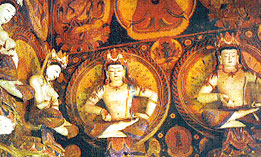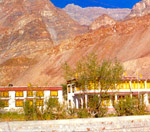|
|

|
|

|
|||
|
|||

Tibetan scholar Rin-Chan-Sang-Po was chosen by Ye-She-O, who had renounced the Tibetan throne and taken to the religious order, to be sent to India for Buddhist studies. He visited India thrice and spend 17yrs in the Sutlej valley area of Kinnaur and in Spiti in Himachal. There he built 108 viharas, most of which were built with the help of 32 Kashmiri Buddhist artists headed by Bidhaka. The important monasteries associated with him are Tabo (the Ajanta of the Himalaya), Kanam, Gamur and Dhankar. 
Tobo is situated in Lower Spiti on the bank of Spiti river. It is at a height of of 3050mts and is a complex that holds 9 temples, 23 chortens, a monk's chamber and an extension that houses the nun's chamber. This complex, 6300sq.mts in area is surrounded by a high mud wall. The centre of interest is the main temple in which is installed the central divinity, a four fold white stucco image of Vairochana, below which are placed two images of Rin-Chan-Sang-Po. Four other Buddhas each flanked by four Bodhisattvas are set against the side walls. In the temple there are varied inscriptions, one of them tells about the foundation of the monastery about 1000 years ago and about the people connected with that event. Against the walls of entry are set four feminine divinities and just inside the doorway two fierce male ones.
Around the walls beneath the images of Vauochana's circle of divinities, there are a series of frescos. Those along the left wall tell the story of the Prince of Bodhisattva, Nov-sang, while those to the right depict the story of Sakya-muni. Just short of the complex are the contemporary monastic structures. On the sheer cliff face above the enclave are a series of caves which were used as dwelling units by the monks and includes an assembly hall. Here dim traces of the paintings that once adorned the rock face are visible. In June-July 1996, Tabo celebrated a millennium of its glorious existence. With breath-taking murals and stucco images, Tabo is often called 'The Ajanta of the Himalayas'.
|
|||